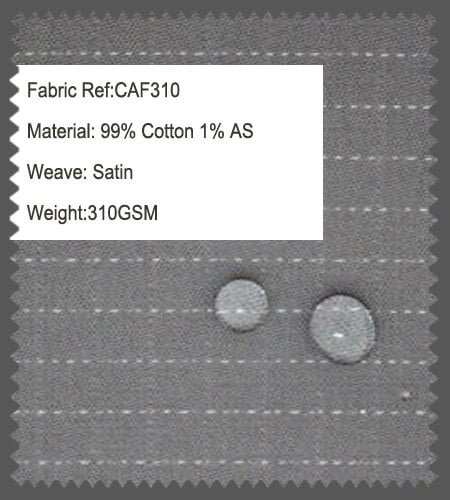When most people think of flame retardant fabrics, they think of clothing that is used to protect people from fires to make sure workers’ safety. Some of the most common applications for fire retardant fabrics include ironworkers, firefighters, aircraft interiors, Automotive, Petrochemical, Power energetics, and other industries.
What is (FR) flame retardant fabric
Flame retardant fabrics are used to make clothing that protects workers from serious injury when struck by arcs, flames, or molten metal. These self-extinguishing fabrics will not continue burning after the heat source has been removed and don’t melt even if exposed at high temperatures.
There are two types of fire retardant fabrics, which are Inherent FR fabric and treated FR fabric. Each class has unique attributes that make them advantageous for intense heat or open flame applications, but they use different mechanisms to do so.
Inherently flame retardant fabrics widely used in firefighting
Inherently Flame retardant fabric
When a fabric is said to have inherent fire retardant fabrics, it means that at least one of the fibers used in the fabric has its own fire-resistant properties. The most common FR fibers used in protective clothing are modacrylics and aramids. These fibers provide excellent protection against flames and heat.
FR modacrylic and FR aramids are the most common fibers found in fire-resistant fabrics because they not only offer good fire resistance but also have high abrasion resistance. Generally speaking, the higher the Density number for these two types of fibers-the better protection you can expect to get from them in a fabric form. FR Modacrylics are available in both filament form (e.g., FR Kevlar®) and staple form (e.g., FR Twaron®). Both forms have been used for fire resistance clothing.
FR modacrylics have a number of advantages, including very good color fastness and FR protection at comparatively high temperatures. In terms of disadvantages, FR modacrylics are typically more expensive than cotton fire retardant fabrics. Furthermore, FR modacrylic fabrics typically do not offer the same level of fire resistance as FR cotton.
Conversely, FR Aramid Fiber is a fiber developed from para-aramid synthetic fibers that have great thermal stability and a low chance to melt under normal conditions. To get your ultimate protection from FR Aramid Fabrics; make sure you purchase garments with multiple layers; especially in the areas most exposed to heat such as shoulders, arm, and chest. FR Aramid Fiber is not only fire-resistant but also very cut resistant.”
Inherent fire-resistant fabrics are a great choice for those looking for an FR garment that is both safe and lightweight.
When it comes to inherent fire-resistant fabrics, one of the biggest benefits is that the fabric is lightweight and typically comfortable to wear. This makes it a great choice for those who need fire-resistant protection but don’t want to sacrifice comfort. Additionally, inherent FR fabrics have excellent color-fastness, meaning that they will not fade even after numerous washings.
One of the main cons of inherent fire-resistant fabrics is that they typically offer limited protection against molten metal splash. Additionally, inherent FR fabrics can be more expensive than flame-resistant treated fabrics.

Flame retardant fabrics can be varied and can be mixed with a variety of fibers.
Treated fire retardant fabrics
FR treated fabrics are based on cotton (natural fibers), blended with polyester, para-aramid, or polyamide. These fabrics need to be chemically treated to get their FR property. This treatment is executed in such a way that it fully penetrates the fiber and as such is bonded throughout the entire fabric. As a result of this treatment, the fabric becomes fire retardant and keeps this property during the lifetime of the garment.
When it comes to FR-treated fabrics, one of the biggest pros is that the fabric offers excellent protection against ARC and heat, good protection against molten metal. Additionally, these after-treatment fabrics are typically less expensive than inherent FR fabrics. This makes them a great choice for those who need FR protection but don’t want to sacrifice affordability.
One of the biggest cons is that the fabric can be less comfortable than inherent FR fabrics. This is because FR-treated fabrics are typically a bit heavier than inherent FR fabrics. Additionally, FR-treated fabrics can sometimes lose their fire-retardant properties after repeated washings.
Which flame-resistant fabric materials should you choose for your application
When it comes to choosing a fire retardant material, there are a few things you need to keep in mind. First, you need to decide what type of application you are using the material for. Are you looking for FR clothing, FR curtains, or FR upholstery?
Once you have determined the type of application, you need to decide which type of flame retardant material is best suited for the job. If you are looking for FR clothing, you may want to consider using a cotton-based fire retardant fabric. This type of fabric is based on cotton or blended with polyester, para-aramid, or polyamide. The fabric gets its FR property from the treatment that is applied to it, which fully penetrates the fiber there are a number of fire retardant materials that can be used, depending on the specific needs of the project.
Cotton based flame retardant fabrics are widely used in heavy industry
Tips on how to wash flame-retardant garments over time
There are a few key things to keep in mind when washing FR garments. First, make sure to use lukewarm water- no higher than 75 degrees Celsius. Second, avoid using chlorine bleach or any other type of bleach. Chlorine bleach can damage the fabric and make it less flame-resistant. Third, avoid using fabric softeners. They can leave a flammable residue on the clothing and make it more likely to catch fire if it does ignite. Finally, avoid using soap with a high-fat content- it can have the same effect as fabric softeners.
Conclusion
There are many different types of FR materials, each with pros and cons that should be considered before choosing the material. fire retardant fabric is based on cotton, blended with other fibers and the FR property comes from the chemical treatment that’s applied to it. This type of material is typically more affordable than an inherent FR fabric but offers less protection against molten metal splash than an FR-treated fabric does. When shopping for flame retardant fabrics you need to consider what application they will be used for (i.e., clothing vs upholstery) as well as which type of FR properties would best suit your needs (i.e., do you want ARC resistance?).
More information on FR fabric
LEVITEX is a manufacturer in the production of custom textiles for industrial applications. We have over 60 years of combined experience. Our fabric meet strict safety standards to ensure that they are as safe as possible while also meeting industry demands
We can help you find what your needs may be with our research team’s expertise and creative mindsets capable enough even create new types if needed Contact us today or request a quote to see how efficiently this firm could serve any operation looking out to protect its employees from harm.
